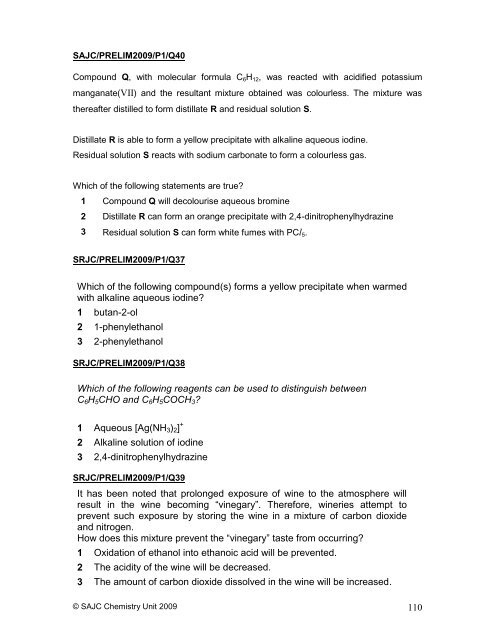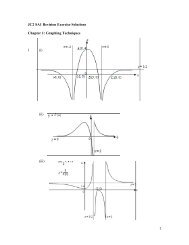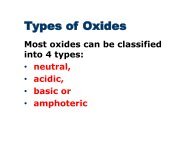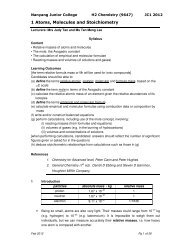Papers included in this bank - ASKnLearn
Papers included in this bank - ASKnLearn
Papers included in this bank - ASKnLearn
- No tags were found...
You also want an ePaper? Increase the reach of your titles
YUMPU automatically turns print PDFs into web optimized ePapers that Google loves.
SAJC/PRELIM2009/P1/Q40Compound Q, with molecular formula C 6 H 12 , was reacted with acidified potassiummanganate(VII) and the resultant mixture obta<strong>in</strong>ed was colourless. The mixture wasthereafter distilled to form distillate R and residual solution S.Distillate R is able to form a yellow precipitate with alkal<strong>in</strong>e aqueous iod<strong>in</strong>e.Residual solution S reacts with sodium carbonate to form a colourless gas.Which of the follow<strong>in</strong>g statements are true?1 Compound Q will decolourise aqueous brom<strong>in</strong>e2 Distillate R can form an orange precipitate with 2,4-d<strong>in</strong>itrophenylhydraz<strong>in</strong>e3 Residual solution S can form white fumes with PCl 5 .SRJC/PRELIM2009/P1/Q37Which of the follow<strong>in</strong>g compound(s) forms a yellow precipitate when warmedwith alkal<strong>in</strong>e aqueous iod<strong>in</strong>e?1 butan-2-ol2 1-phenylethanol3 2-phenylethanolSRJC/PRELIM2009/P1/Q38Which of the follow<strong>in</strong>g reagents can be used to dist<strong>in</strong>guish betweenC 6 H 5 CHO and C 6 H 5 COCH 3 ?1 Aqueous [Ag(NH 3 ) 2 ] +2 Alkal<strong>in</strong>e solution of iod<strong>in</strong>e3 2,4-d<strong>in</strong>itrophenylhydraz<strong>in</strong>eSRJC/PRELIM2009/P1/Q39It has been noted that prolonged exposure of w<strong>in</strong>e to the atmosphere willresult <strong>in</strong> the w<strong>in</strong>e becom<strong>in</strong>g “v<strong>in</strong>egary”. Therefore, w<strong>in</strong>eries attempt toprevent such exposure by stor<strong>in</strong>g the w<strong>in</strong>e <strong>in</strong> a mixture of carbon dioxideand nitrogen.How does <strong>this</strong> mixture prevent the “v<strong>in</strong>egary” taste from occurr<strong>in</strong>g?1 Oxidation of ethanol <strong>in</strong>to ethanoic acid will be prevented.2 The acidity of the w<strong>in</strong>e will be decreased.3 The amount of carbon dioxide dissolved <strong>in</strong> the w<strong>in</strong>e will be <strong>in</strong>creased.© SAJC Chemistry Unit 2009 110

















